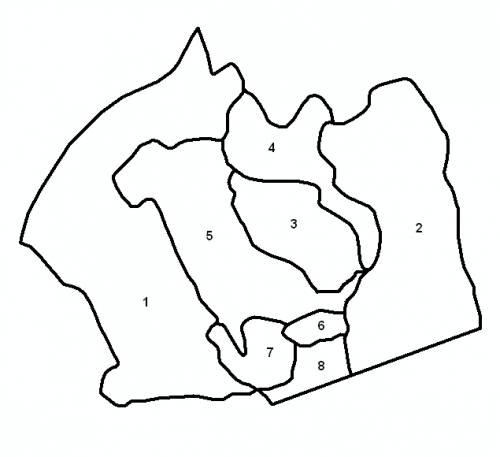Difference between revisions of "Preparing spatial analyses"
| Line 6: | Line 6: | ||
|} | |} | ||
*'''Adjacencies''' | *'''Adjacencies''' | ||
| − | In "Tools" > "Adjacencies..." the analysis area of interest is first selected. By doing this, a problem concering edges occur, and the extent of this problem depends on the selected area. In the figure above, it can be seen that "Landscape8" will suffer from quite extensive edge effects, especially stand number one and two. ''Any opening sizes including these stands will depend on areas outside the analysis area and treatments herein.'' | + | In "Tools" > "Adjacencies..." the analysis area of interest is first selected. By doing this, a problem concering edges occur, and the extent of this problem depends on the selected area. In the figure above, it can be seen that "Landscape8" will suffer from quite extensive edge effects, especially stand number one and two. ''Any opening sizes including these stands will depend on areas outside the analysis area and any treatments herein.'' |
To each stand, i.e. treatment unit (TU), adjacent stands, called "Neighbours", are derived and the length of the common borders are calculated (in meters). An example of a permutation in this case is ''CommonBorderLength_TU1_TU2 = CommonBorderLength_TU2_TU1''. Another example, stressing the difference between "null" and the value 0 (zero), can be seen in the figure above; stand number eight share common borders with stand two, six, and seven where the length is > 0 meters. But with stand number one this common border length is = 0 meters - the two stands are adjacent in a point only. In later parts of the analyses the user will have to decide if these two areas (of stand number one and eight) should be added or not, if harvested in the same period, to form an opening size. ''What do you think? How important are, e.g., forested corridors or are your only concern the scenic values?'' | To each stand, i.e. treatment unit (TU), adjacent stands, called "Neighbours", are derived and the length of the common borders are calculated (in meters). An example of a permutation in this case is ''CommonBorderLength_TU1_TU2 = CommonBorderLength_TU2_TU1''. Another example, stressing the difference between "null" and the value 0 (zero), can be seen in the figure above; stand number eight share common borders with stand two, six, and seven where the length is > 0 meters. But with stand number one this common border length is = 0 meters - the two stands are adjacent in a point only. In later parts of the analyses the user will have to decide if these two areas (of stand number one and eight) should be added or not, if harvested in the same period, to form an opening size. ''What do you think? How important are, e.g., forested corridors or are your only concern the scenic values?'' | ||
Revision as of 09:44, 15 September 2009
The most common spatial analyse in forest management planning concern the aggregation of final felled areas. An aggregation could be positive (e.g. when aggregated stands share the fixed costs involved in harvesting) but usually regarded as a problem - large open areas are negative in nature preservation perspectives, in biological diversity matters, etc. "Opening size constrains" are hence often used in a optimization model. Prerequisites for such analyses can be calculated in PlanStart.
NB: "Harvest" is here corresponding to final felling, sometimes also called clearcut. Harvesting is done in thinning but a stand will, after such treatment, not show an open area. A problem occur when seed trees are retained in final fellings. However, the stem density is usually quite low (less than 150 stems per hectare), where quite a few usually will be windthrown in the first couple of years, and hence regarded as an opening.
- Adjacencies
In "Tools" > "Adjacencies..." the analysis area of interest is first selected. By doing this, a problem concering edges occur, and the extent of this problem depends on the selected area. In the figure above, it can be seen that "Landscape8" will suffer from quite extensive edge effects, especially stand number one and two. Any opening sizes including these stands will depend on areas outside the analysis area and any treatments herein.
To each stand, i.e. treatment unit (TU), adjacent stands, called "Neighbours", are derived and the length of the common borders are calculated (in meters). An example of a permutation in this case is CommonBorderLength_TU1_TU2 = CommonBorderLength_TU2_TU1. Another example, stressing the difference between "null" and the value 0 (zero), can be seen in the figure above; stand number eight share common borders with stand two, six, and seven where the length is > 0 meters. But with stand number one this common border length is = 0 meters - the two stands are adjacent in a point only. In later parts of the analyses the user will have to decide if these two areas (of stand number one and eight) should be added or not, if harvested in the same period, to form an opening size. What do you think? How important are, e.g., forested corridors or are your only concern the scenic values?
Adjacencies are a prerequisite in deriving cliques and clusters but can also be used separately in analyzing forest management schemes.
- Cliques and Clusters
In "Tools" > "Compute Cliques and Harvest Clusters" the analysis area is first selected. Adjacencies needs to be calculated prior to this calculation.
